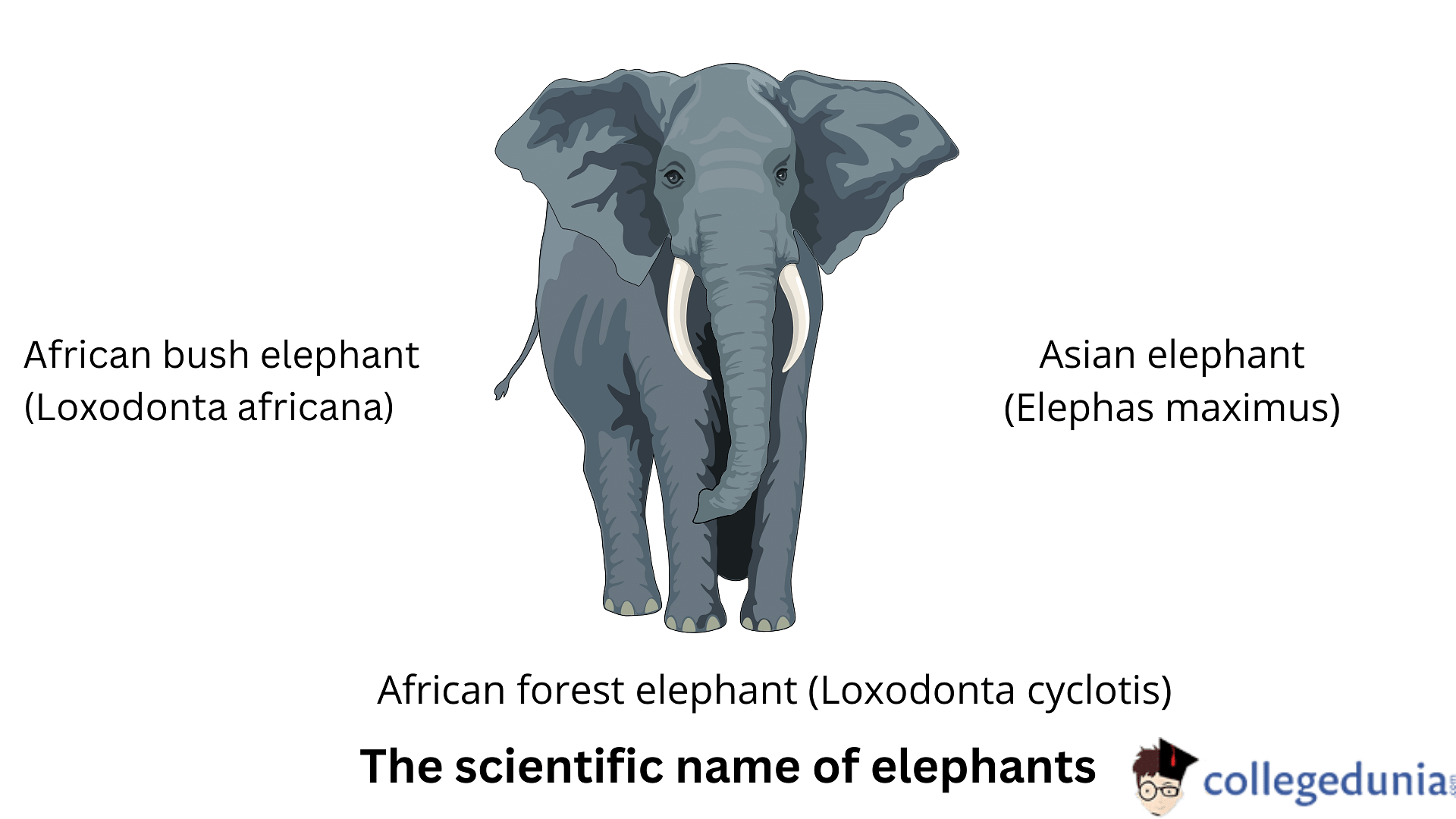Collegedunia Team Content Curator
Content Curator
Elephants are from the family of Elephantidae, which incorporates the other three extant elephant species alongside the extinct species as well as straight-tusked elephants and mammoths. One of the most important characteristics of elephants is their long nose, enormous floppy ears, trunks, wide legs. The scientific names of the various species of elephants are:
- African bush elephant (Loxodonta africana)
- Asian elephant (Elephas maximus)
- African forest elephant (Loxodonta cyclotis)
Also Check: Scientific Name of Honeybee
| Table of Content |
Key Terms: Elephants, Taxonomy, Kingdom, Phylum, Elephantidae, Loxodonta Africana, Herbivores, Chordata
Scientific Name of Elephants
[Click Here for Sample Questions]
Elephants were classified under two species, the African (Loxodonta africana) and Asian (Elephas maximus) elephants. They belong to the family of Elephantidae. Preliminary genetic studies show that there are at least two subspecies of African elephants, which are the savanna (Loxodonta africana africana) and forest (Loxodonta africana cyclotis) elephants.
- Elephants typically weigh almost 5,000 to 14,000 pounds.
- The African Elephant's lifespan is roughly about 70 years in total.
- The scientific name of the elephant (African) is Loxodonta Africana.
- The lifespan of the Asian Elephant is almost 60 years which is comparatively lesser than the African elephants.
One of the most vital characteristics of elephants is their long nose, giant floppy ears, trunks, and wide legs. The scientific names of other species of elephants are:
- African bush elephant (Loxodonta africana)
- Asian elephant (Elephas maximus)
- African forest elephant (Loxodonta cyclotis)

Classification of Elephants
[Click Here for Previous Year Questions]
Elephants are the only living representatives of their order right now is Elephants, which once also included the mammoth and the mastodon. Elephants can be classified in the following manner:
| Type | Classification |
|---|---|
| Family | Elephantidae |
| Phylum | Chordata |
| Sub-phylum | Vertebrata |
| Class | Mammalia |
| Order | Proboscidea |
Habitat of Elephants
[Click Here for Sample Questions]
Elephants are mostly found in savannas, grasslands, and forests. However, they are seen to occupy a wide range of habitats, especially deserts, swamps, and highlands. All of these are mostly in tropical and subtropical regions of both Africa and Asia.
- Most African elephants take up the regions of Sub-Saharan Africa.
- Elephants are typically densely populated in West and Central Africa.
- They can also be found in the Sahel Desert, situated in Mali.
- Asian elephants, on the other hand, are found in India, Nepal, and several places in Southeast Asia.
- The African elephants are usually relatively larger when compared on the basis of size. Usually, elephants are herbivores in nature.
Read Also:
Previous Year Questions
- Which of the following taxonomic categories of housefly is… (KEAM)
- Bladderworm/cysticercus is the larval stage of… (NEET 1991)
- Edaphology is… (KCET 2007)
- Read the statements given below and identify the incorrect statement… (KCET 2012)
- Small mammals and birds are rarely found in polar regions … (KCET 2021)
- Which of the following is not an attribute of a population … (NEET 2020)
- The process of growth is maximum during … (NEET 2020)
- Which one of the following is oviparous?... (NEET 2015)
- Which one of the following statements about certain given animals is correct?... (NEET 2010)
- Which of the following organisms possesses characteristics of a plant and an animal? (NEET 1995)
Things to Remember
- Elephants belong to the family of Elephantidae.
- Elephants are typically found in savannas, grasslands, and forests.
- The order of Elephants is Proboscidea.
-
The scientific names of other species of elephants are: African bush elephant (Loxodonta africana), Asian elephant (Elephas maximus) and African forest elephant (Loxodonta cyclotis).
Read More:
Sample Questions
Ques. What is the scientific name of the African Bush Elephant? [1 mark]
Ans. The scientific name of the African Bush Elephant is (Loxodonta africana).
Ques. How can elephants survive in hotter climates? [2 marks]
Ans. Animals can use several methods of cooling in hot and warm weather. For instance, the surface area of an elephant’s ears functions as a heat radiator and helps them to stay cool. Elephants, in hot weather, elevate the blood supply to the ears and further flap their ears to lose body heat.
Ques. What is the habitat of elephants? [2 marks]
Ans. Elephants are usually found in savannas, grasslands, and forests. They also cover several habitats, especially deserts, swamps, and highlands. All of these are mostly in tropical and subtropical regions of both Africa and Asia.
Ques. How much does elephants weigh and what is their lifespan? [2 marks]
Ans. Elephants weigh almost about 5,000 to 14,000 pounds. The African Elephant's lifespan is typically about 70 years in total.
Ques. What is the phylum of Elephants? [1 mark]
Ans. The phylum of Elephants is Chordata.
Ques. Where are elephants generally densely populated? [2 marks]
Ans. Elephants are densely populated in West and Central Africa. Elephants are also equally found in the Sahel Desert, situated in Mali. Asian elephants, on the other side, are found in India, Nepal and several places in Southeast Asia.
Read Also:




Comments